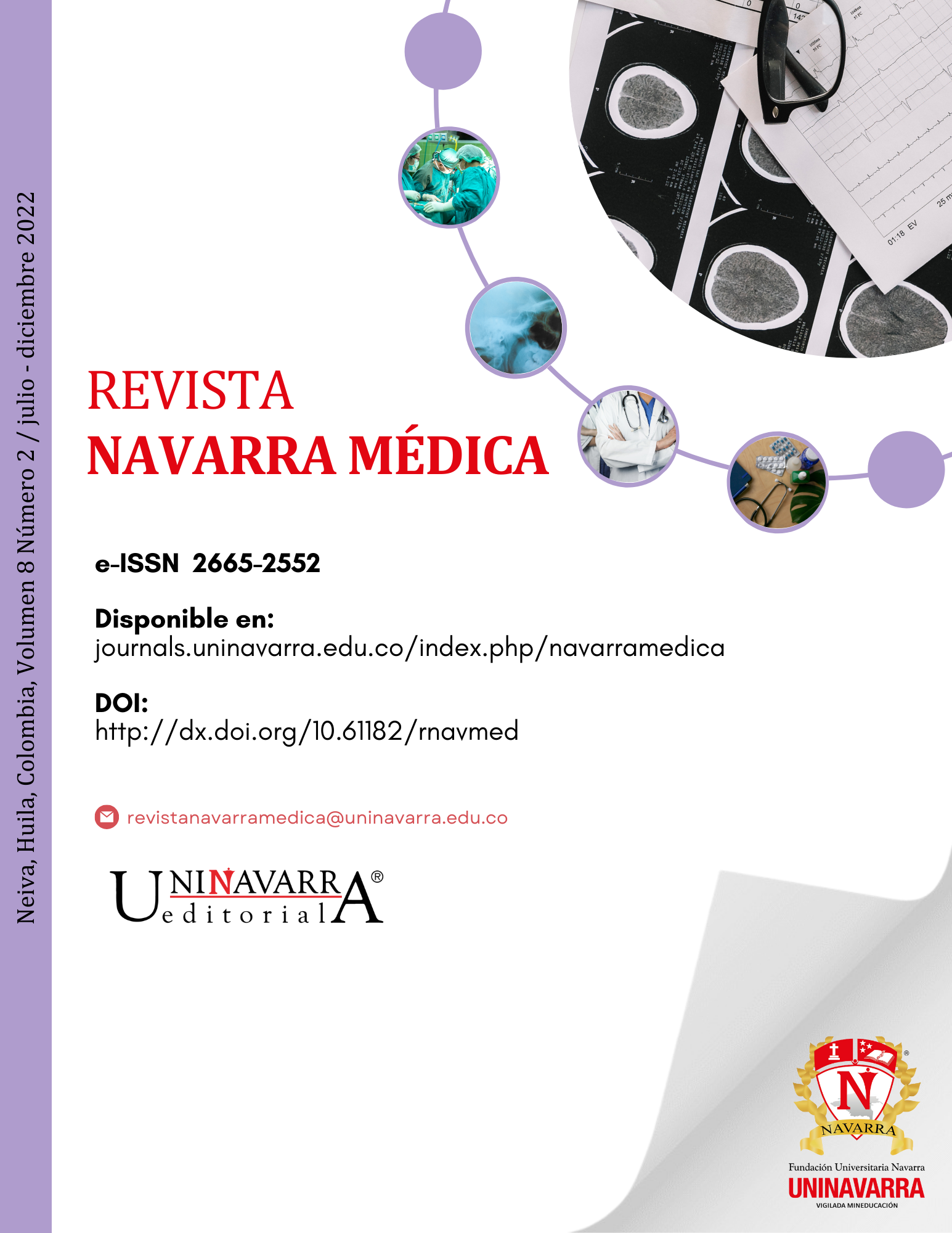Validation of the DENVER Score for predicting multiple organ failure in Trauma Patients Treated at a University Hospital in Colombia
DOI:
https://doi.org/10.61182/rnavmed.v8n2a1Keywords:
DENVER Scale, Multiorganic Failure, TraumaAbstract
Introduction: Trauma is one of the pathologies that generate the greatest disability and mortality in Latin America. The aim of this study was to evaluate the usefulness of the DENVER classification to predict multiorgan failure in trauma victims who were treated in a university hospital in southern Colombia.
Materials and Methods: A database of traumatized patients who entered the emergency department between 2012 and 2015 was built. The effectiveness of the DENVER scale to predict multiorgan failure in trauma patients was evaluated, a univariate analysis was performed. Measures of central tendency and dispersion were calculated for the continuous variables, statistical confidence tests were applied, a p <0.05 was considered as significant.
Results: In total, 598 patients were analyzed. The mean age was 24.6 years (range 16 - 58). The median of the GCS was 5 (range 3-12), 86.7 % were men, 83.4 % had blunt trauma, of the patients who entered the institution 12.5 % had multiorgan failure, the overall mortality was 5.7%, the DENVER scale predicted multi-organ failure in 87.5 %.
Conclusion: Trauma is a public health problem, it is a frequent pathology in our hospital, multiorganic failure is a complication that occurs in trauma victims, DENVER is a model that has been described with the objective of identifying patients early that can develop multiorganic dysfunction syndrome and
References
1. Byass P, de Courten M, Graham WJ, Laflamme L, McCaw-Binns A, Sankoh OA, et al. Reflections on the Global Burden of Disease 2010 Estimates. PLoS Med. 2013;10(7): e1001477. doi:10.1371/journal.pmed.1001477
2. Horton R. GBD 2010: understanding disease, injury, and risk. Lancet. 2012;380(9859):2053-4. doi:10.1016/S0140-6736(12)62133-3
3. Norton R, Kobusingye O. Injuries. N Engl J Med. 2013;368(18):1723-30. doi:10.1056/NEJMra1109343
4. Chisholm D, Rehm J, Van Ommeren M, Monteiro M. Reducing the global burden of hazardous alcohol use: a comparative cost-effectiveness analysis. J Stud Alcohol. 2004;65(6):782-93. doi: 10.15288/jsa.2004.65.782
5. Vargas Castillo DA. Comportamiento de muertes y lesiones por accidente de transporte en Colombia, 2013. Forensis datos para la vida. 2014;15(1): 171-220. Disponible en https://www.medicinalegal.gov.co/documents/20143/49517/Accidentes+de+transporte.pdf
6. Medina E, Kaempffer A. Consideraciones epidemiológicas sobre los traumatismos en chile. Rev Chil Cir.2007;59(3):175-84. doi:10.4067/S0718-40262007000300003
7. Ordoñez CA, Pino LF, Tejada JW, Badiel M, Loaiza JH, Mata LV, et al. Experencia en dos hospitales de tercer nivel de atención del suroccidente de Colombia en la aplicación del registro internacional de trauma de la sociedad panamericana de trauma (RIT/SPT-ITSDP). Rev Col BrasCir. 2012;39(4):255-262. doi:10.1590/S0100-69912012000400003
8. Rehm J, Room R, Monteiro M, Gmel G, Graham K, Rehn N, et al. Alcohol as a risk factor for global burden of disease. Eur Addict Res. 2003;9(4) 157-64. doi:10.1159/000072222
9. Pridemore WA, Chamlin MB. A time-series analysis of the impact of heavy drinking on homicide and suicide mortality in Russia, 1956–2002. Addiction. 2006;101(12):1719–29. doi:10.1111/j.1360-0443.2006.01631.x
10. Klimkiewicz A, Jakubczyk A, Wnorowska A, Klimkiewicz J, Bohnert A, Ilgen MA, et al. Violent behavior and driving under the influence of Alcohol: prevalence and association with impulsivity among individuals in treatment for alcohol dependence in Poland. Eur Addict Res. 2014;20(3):151-8. doi:10.1159/000356192
11. Saar I. Do Alcohol Excise Taxes Affect Traffic Accidents? Evidence From Estonia. Traffic Inj Prev. 2015;16:213-8. doi:10.1080/15389588.2014.933817
12. Ju Y, Sohn SY. Time to death analysis of road traffic accidents in relation to delta V, drunk driving, and restraint systems. Traffic Inj Prev. 2014;15(8):771-7. doi:10.1080/15389588.2013.879575
13. Huang CM, Lunnen JC, Miranda JJ, Hyder AA. Traumatismos causado por el tránsito en países en desarrollo: agenda de investigación y acción. Rev Peru Med Exp Salud Publica. 2010;27(2):243-7.
14. Briceño-Leon R, Villaveces A, Concha-Eastman A. Understanding the uneven distribution of the incidence of homicide in Latin America. Int J Epidemiol. 2008;37(4):751–7. doi: 10.1093/ije/dyn153
15. Hsieh CH, Su LT, Wang YC, Fu CY, Lo HC, Lin CH. Does alcohol intoxication protect patients from severe injury and reduce hospital mortality? The association of alcohol consumption with the severity of injury and survival in trauma patients. Am Surg. 2013;79(12):1289-94.
16. Sánchez AI, Villaveces A, Krafty RT, Park T, Weiss HB, Fabio A, et al. Policies for alcohol restriction and their association with interpersonal violence: a time-series analysis of homicides in Cali, Colombia. Int J Epidemiol. 2011;40(4):1037-46. doi:10.1093/ije/dyr051
17. Villaveces A, Cummings P, Koepsell TD, Rivara FP, Lumley T, Moffat J. Association of alcohol-related laws with deaths due to motor vehicle and motorcycle crashes in the United States, 1980-1997. Am J Epidemiol. 2003;157(2):131-40. doi: 10.1093/aje/kwf186
Downloads
Published
Issue
Section
License
Copyright (c) 2025 Sergio A. Cristancho-Losada , Jose D. Charry, Roberto J. Rodriguez

This work is licensed under a Creative Commons Attribution-NonCommercial 4.0 International License.








